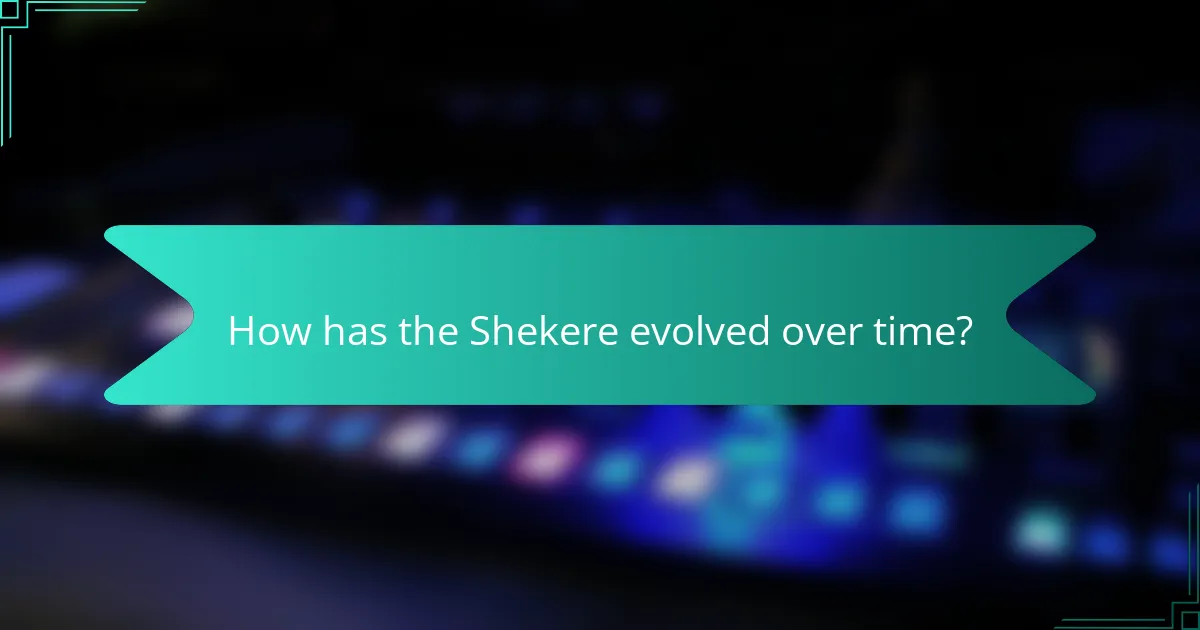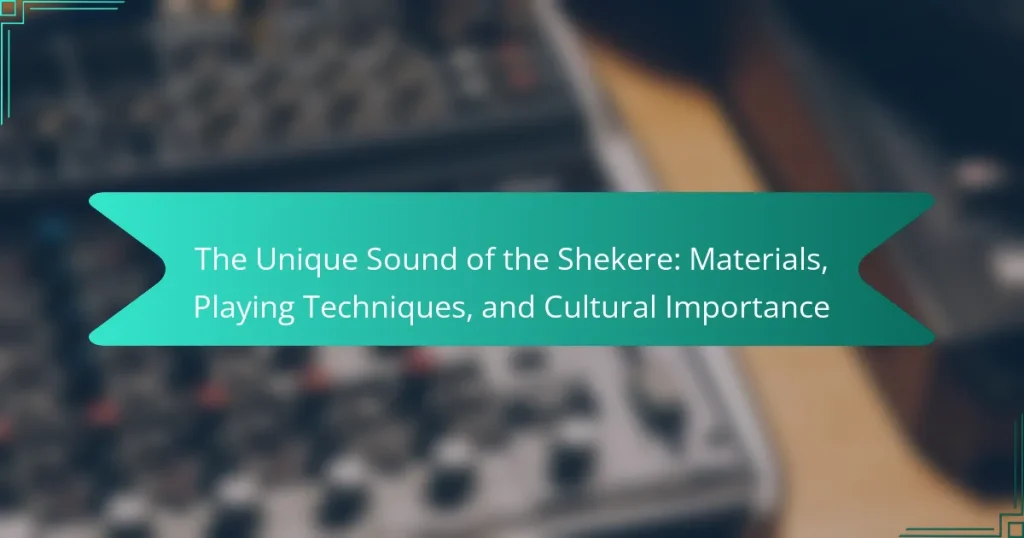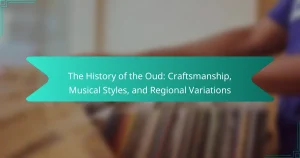The Shekere is a percussion instrument originating from West Africa, made from a gourd covered with a net of beads. It plays a vital role in various music genres, enhancing rhythmic patterns and symbolizing community and heritage during ceremonies and cultural performances. The article explores the Shekere’s evolution from traditional materials to synthetic alternatives, its diverse playing techniques, and its integration into global music styles. Additionally, it emphasizes the importance of practice in mastering the instrument to achieve a fuller sound. Overall, the Shekere’s unique sound and cultural significance highlight its essential role in musical traditions.

What is the Shekere and its significance in music?
The Shekere is a percussion instrument made from a gourd covered with a net of beads. It originates from West Africa and is significant in various music genres, including traditional African music and contemporary styles. The Shekere produces a distinct sound when shaken or struck, enhancing rhythmic patterns in music. It is often used in ceremonies, celebrations, and cultural performances, symbolizing community and heritage. The instrument’s unique sound contributes to the overall texture of musical ensembles, making it an essential component in many African musical traditions. Its versatility allows it to be integrated into various musical contexts, from folk to modern fusion genres.
How is the Shekere traditionally constructed?
The Shekere is traditionally constructed using a gourd as its main body. The gourd is hollowed out and dried to create a resonating chamber. A net made from beads or rope is then woven around the gourd. This net is designed to hold small stones or seeds, which create sound when the Shekere is shaken. The construction process often involves handcrafting techniques passed down through generations. Artisans may also decorate the Shekere with intricate designs, reflecting cultural significance. Traditional methods ensure the instrument retains its unique sound and character. The Shekere’s construction varies slightly among different cultures, but the core elements remain consistent.
What materials are commonly used in Shekere production?
Shekere production commonly uses gourd and beads. Gourds serve as the primary body of the instrument. They are hollowed out and dried to create a resonant chamber. Beads, often made from wood or plastic, are strung around the gourd. These beads create a unique sound when shaken. The combination of the gourd and beads contributes to the shekere’s distinctive tonal quality. This traditional instrument has roots in African music and culture. Its materials reflect both functionality and cultural significance in musical practices.
How do different materials affect the sound of the Shekere?
Different materials significantly affect the sound of the Shekere. The primary materials used are gourd, wood, and synthetic options. Gourds produce a warm, resonant tone with rich overtones. Wood Shekeres offer a sharper, crisper sound due to their density. Synthetic materials can create consistent sound quality and durability, but may lack the warmth of natural materials. The thickness and treatment of the material also influence the volume and tonal quality. Thinner materials tend to produce higher pitches, while thicker materials yield deeper sounds. Historical use shows that traditional Shekeres made from gourds are preferred for authentic sound in cultural performances.
What are the unique sounds produced by the Shekere?
The Shekere produces a variety of unique sounds characterized by its textured surface and hollow body. These sounds include a sharp, rhythmic clapping when struck with the palm. The shaking of the Shekere creates a rattling sound from its beads. Additionally, the Shekere can produce a deep, resonant tone when played with varying pressure. The combination of these sounds contributes to its distinctive percussive quality. The Shekere’s construction, often from gourd, enhances its acoustic properties. Different playing techniques can further modify the sound, allowing for dynamic expression in music.
How does the shape of the Shekere influence its sound?
The shape of the Shekere significantly influences its sound. The rounded body creates a resonant chamber, enhancing the volume and richness of the sound produced. A wider Shekere generates a deeper tone, while a narrower one produces higher pitches. The thickness of the material also affects the sound; thicker shells yield a more muted sound, while thinner shells offer brighter tones. The unique shape allows for varied playing techniques, such as shaking or striking, which further modifies the sound. Historical use in African music demonstrates these characteristics, as different shapes are preferred for specific musical contexts.
What playing techniques create distinct sounds on the Shekere?
The Shekere produces distinct sounds through various playing techniques. Shaking the Shekere creates a rhythmic sound as the beads strike the gourd. Tapping the surface with fingers produces sharp, percussive tones. Rubbing the hands along the gourd generates a smooth, resonant sound. Striking the gourd with the palm results in deep, bass-like notes. Each technique emphasizes different tonal qualities. These methods are rooted in traditional African music practices. They enhance the Shekere’s role in ensemble settings. The versatility of the Shekere is evident in its diverse sound production.

How has the Shekere evolved over time?
The Shekere has evolved significantly over time. Originally, it was made from natural materials like gourds and animal skins. These materials provided a unique sound quality. As cultures interacted, the Shekere’s construction began to include synthetic materials. This shift allowed for greater durability and varied sound production. Additionally, playing techniques have diversified, influenced by various musical styles. The Shekere is now used in genres beyond traditional African music. Its cultural importance has expanded globally, integrating into world music. The evolution reflects broader changes in musical expression and cultural exchange.
What historical contexts have shaped the Shekere’s development?
The Shekere’s development has been shaped by various historical contexts, particularly within African cultures. Originating in West Africa, it has roots in traditional rituals and ceremonies. The Shekere was used in religious practices to accompany dances and storytelling. Its construction evolved through interactions with different cultures during trade and colonization. The introduction of new materials influenced its design and sound. Additionally, the diaspora of African people contributed to its spread and adaptation in various music genres globally. These historical contexts highlight the Shekere’s cultural significance and evolution over time.
How have cultural influences impacted Shekere construction?
Cultural influences have significantly impacted Shekere construction. Various African cultures have contributed unique design elements. For example, the Yoruba people use specific gourd shapes that resonate differently. The materials used, such as beads and shells, vary by region and cultural significance. These materials enhance the sound quality and visual appeal. Additionally, traditional rituals influence the decoration and craftsmanship of the Shekere. Different tribes incorporate distinct patterns and colors that represent their heritage. The evolution of the Shekere reflects the diverse musical traditions across Africa. Each cultural influence adds layers of meaning and functionality to the instrument.
What innovations have been introduced in modern Shekere designs?
Modern Shekere designs have introduced several innovations that enhance their sound and playability. These innovations include the use of synthetic materials, which provide durability and consistency in sound quality. Traditional Shekeres are often made from gourds, but modern versions incorporate materials like fiberglass and plastic. This shift allows for a wider range of tonal options and reduces weight. Additionally, advancements in string technology have improved the resonance and projection of the instrument. Some contemporary Shekeres feature adjustable tension mechanisms for customizable sound dynamics. These design changes reflect a blend of traditional craftsmanship with modern musical needs. Overall, these innovations have expanded the Shekere’s versatility across various music genres.
Why is the Shekere important in various cultural traditions?
The Shekere is important in various cultural traditions due to its role in music and ritual. This traditional instrument enhances performances and ceremonies across African, Caribbean, and Latin American cultures. It serves as a rhythmic accompaniment, fostering community and connection during gatherings. The Shekere is often used in religious ceremonies, symbolizing [censured] and cultural identity. Its unique sound is produced by the gourd body and the beads or shells strung around it. This instrument’s significance is evident in its use during celebrations, storytelling, and dance. The Shekere also represents cultural heritage, preserving traditions through generations.
What role does the Shekere play in African music and dance?
The Shekere is a significant percussion instrument in African music and dance. It provides rhythmic support and enhances the overall sound of musical ensembles. The Shekere is made from a gourd covered with a net of beads or shells. This construction allows it to produce distinctive sounds when shaken or struck. In various African cultures, the Shekere accompanies traditional dances and ceremonies. It serves to connect performers with their cultural heritage. Additionally, the Shekere is often used in storytelling and communal gatherings. Its presence adds depth and texture to musical performances, enriching the audience’s experience.
How is the Shekere used in contemporary music genres?
The Shekere is used in contemporary music genres as a percussion instrument. It adds rhythm and texture to various styles, including jazz, pop, and world music. In jazz, musicians often incorporate the Shekere to enhance improvisational sections. Pop artists use it to create catchy beats and hooks. In world music, the Shekere maintains its traditional role while blending with modern sounds. Its unique sound comes from the gourd and beads, which produce distinct tones. The Shekere’s versatility allows it to fit seamlessly into diverse musical contexts. Its use in contemporary music reflects a fusion of cultural heritage and modern creativity.

What are effective techniques for playing the Shekere?
To play the Shekere effectively, focus on grip, striking, and shaking techniques. Hold the Shekere firmly with one hand while using the other to strike its surface. Utilize your palm and fingers to create varying tones. Experiment with different striking locations to produce distinct sounds. For shaking, maintain a steady rhythm to enhance the overall beat. Incorporate body movements to add dynamics to your performance. Practicing these techniques helps achieve a fuller sound. Many musicians emphasize the importance of consistent practice to master the Shekere.
How can beginners learn to play the Shekere?
Beginners can learn to play the Shekere by starting with basic techniques. First, familiarize yourself with the instrument’s structure and sound. The Shekere is made from a gourd covered with a net of beads. Practice shaking the Shekere to produce a rhythmic sound. Beginners should focus on keeping a steady beat. Listening to traditional Shekere music can help understand its role in various cultures. Joining a class or workshop can provide hands-on instruction. Online tutorials and videos can also be beneficial for visual learners. Regular practice will improve technique and confidence in playing.
What basic rhythms should new players practice?
New players should practice basic rhythms such as the clave, quarter notes, and eighth notes. The clave rhythm is fundamental in many musical styles and provides a strong foundation. Quarter notes create a steady pulse, essential for timing. Eighth notes add complexity and help develop coordination. Practicing these rhythms improves timing and rhythmic accuracy. Mastery of these basic rhythms is crucial for playing the shekere effectively.
How can advanced techniques enhance Shekere performance?
Advanced techniques can significantly enhance Shekere performance by improving sound quality and versatility. Techniques such as finger rolls, palm slaps, and rhythmic variations allow for a broader range of sounds. These methods enable players to create intricate patterns and dynamic rhythms. Additionally, using different materials for the Shekere can affect tonal clarity. For instance, a Shekere made from harder materials produces sharper sounds. Incorporating technology, like microphones and effects pedals, can further amplify and modify the Shekere’s sound. This integration allows for creative expression in various musical genres. Overall, advanced techniques and innovations expand the Shekere’s role in performances.
What tips can improve Shekere playing skills?
To improve Shekere playing skills, practice consistent rhythm and timing. Focus on hand placement to achieve optimal sound production. Use varying strikes to create dynamic tones. Experiment with different shaking techniques for diverse effects. Incorporate body movements to enhance performance energy. Listen to skilled players for inspiration and technique refinement. Regularly play with other musicians to develop ensemble skills. Record practice sessions to identify areas for improvement.
How does regular practice influence Shekere proficiency?
Regular practice significantly enhances Shekere proficiency. Consistent engagement with the instrument improves muscle memory and coordination. This leads to better control over rhythm and dynamics. Practicing regularly also develops a deeper understanding of the Shekere’s unique sound and playing techniques. Additionally, frequent practice helps musicians internalize various musical styles associated with the Shekere. Research indicates that musicians who practice daily show marked improvement in skill levels. This is supported by studies on motor skill acquisition, which emphasize the importance of repetition. Therefore, regular practice is crucial for mastering the Shekere.
What resources are available for learning Shekere techniques?
Online platforms offer various resources for learning Shekere techniques. Websites like YouTube feature instructional videos from experienced players. These videos demonstrate different playing styles and techniques. Additionally, online courses are available on music education platforms. Books on African percussion often include sections on Shekere techniques. Local music schools may offer workshops or classes focused on Shekere. Community centers sometimes host drumming circles that include Shekere instruction. Joining online forums can provide tips and support from fellow learners. These resources collectively enhance the learning experience for aspiring Shekere players.
The Shekere is a traditional percussion instrument from West Africa, made from a gourd and a net of beads, known for its unique sound that enhances various music genres. This article explores the Shekere’s construction, materials, and the impact of different playing techniques on its sound quality. It also examines the cultural significance of the Shekere in African music, its evolution over time, and its integration into contemporary music. Additionally, the article provides insights into effective playing techniques, resources for learning, and tips for improving proficiency with the Shekere.




